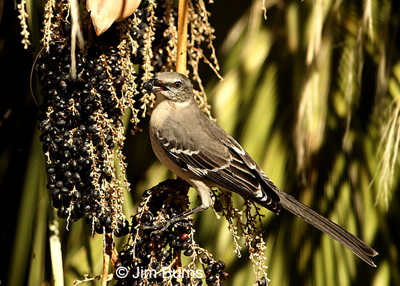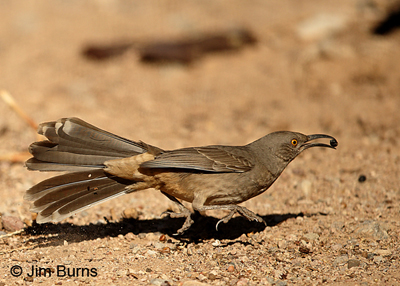
The avian supermarkets, of course, are a more seasonal phenomenon, Saguaros in the spring, sapsucker wells in the winter. To qualify for avian supermarket status I think a natural food source must host at least half a dozen species, and last month I realized birds here in our urban desert were utilizing a fall grocery I had overlooked. I’m not a plant guy, but I believe it is Washingtonia filifera, the Desert Fan Palm.
Desert Fan Palms adorn many of the Valley’s parks and residential areas. I’m not planning on gathering and eating the small purple berries I see ripening and hanging in clusters from these trees in October and November, but they were a food staple of many of the Native American tribes of the desert southwest. In an hour’s observation at one tree I recently counted a baker’s dozen bird species gleaning these edibles, plus a female Anna’s Hummingbird exploring the dead fronds for active spider webs
It was a windy morning and I was out with the camera hoping for some kind of action at a small pond in the park. Hearing palm fronds slapping loudly behind me, I glanced around and caught the white flash of mockingbird wings. Intrigued, I forgot about water birds and walked back to the palm, positioned myself in a clump of bushes with the sun behind me, and hung out for awhile: Gambel’s Quails, Cactus Wrens, Abert’s Towhees, and White-crowned Sparrows gleaning fallen berries from the ground, three woodpecker species, Verdins, mockingbirds (four at one time on occasion), European Starlings, Yellow-rumped Warblers, and Red-winged Blackbirds either hover plucking or hanging from the clusters and picking. A pair of Crissal Thrashers was doing both. I’m guessing the staggered ripening of dates in the Valley runs from early October through mid-December and then, like the birds, I’ll have to find some sapsucker wells where I can hang out with the camera.
The most interesting things to me about the Fan Palm grocery were the interactions of the shoppers and the variety of foraging methods. Did I mention these observations took place on Black Friday? Smaller birds always deferred to larger ones, mockingbirds bumped one another off favored clusters, and on the ground the quail and thrashers chased the sparrows back into the bushes. Larger birds, the mockers and thrashers, hung on the clusters, while the Yellow-rumps hover plucked and the tiny verdins grabbed and fled, seldom landing.
Like some of their urban human counterparts, in the spring in the Saguaros some avian species have adapted to the convenience of living right there above the grocery store. Orioles, lovebirds, Great Horned Owls, and Barn Owls nest in Fan Palms, but the orioles leave for the south before this marketplace opens in the fall, and I doubt I’ll ever see owls eating dates. Maybe I can catch lovebirds foraging before this year’s crop is gone.